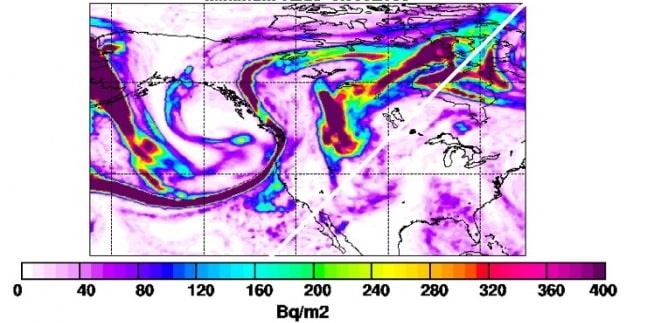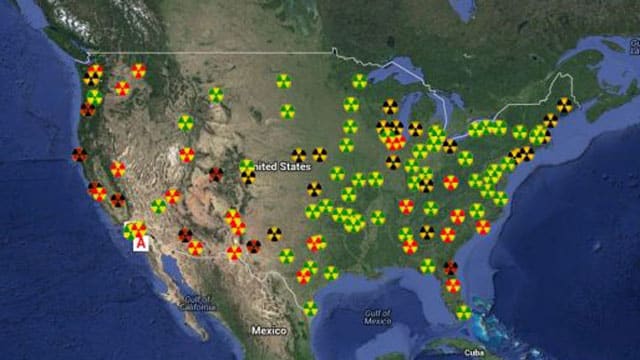Fukushima Radioactive Water to Reach US in 2014 by Life Water Ionizers
Radioactive ocean currents flowing from Japan’s crippled Fukushima Nuclear Power Plant are expected to reach US shores in 2014, with peak flows in 2016. The National Oceanic and Atmospheric Administration (NOAA) has stated that they expect that the radioactive water will be diluted by that time, and pose no risk to the public.

However, a report prepared by scientists from the NOAA’s Pacific Marine Environmental Laboratory and the GEOMAR Research Center for Marine Geosciences contradicts the NOAA’s official stance. That report, prepared last year predicts that radiation off the West Coast could end up being 10 times higher than off the coast of Japan.
Fukushima Radiation: Brought to you by the North Pacific Gyre current
The ocean current that is carrying Fukushima radiation to the US is called the North Pacific Gyre current. The Kuroshio current, the leg of the North Pacific Gyre current closest to Japan, moves northward as it passes Japan, where it picks up contaminated seawater from Fukushima. The Gyre current then heads directly west across the pacific, straight towards the US. Most of the contaminated seawater is expected to remain off the coast, caught in swirling currents that are known as “The Pacific Garbage Patch”.
Is it safe to eat fish?
Many official sources say that fish caught in the pacific ocean should remain safe to eat, but that claim is disputed. The reason for the dispute is that fish exposed to water with radioactive particles in it will accumulate those particles in their bodies over time – just like humans do. This creates two problems:
-
-
Fish exposed to radioactive seawater can become more radioactive as time passes
-
-
Long term consumption of fish with radioactive elements in their bodies could cause people to build up unsafe levels of these radioactive particles in their bodies
The bottom line on fish is that no one knows for sure. The safest bet may be to avoid fish caught in the Pacific Ocean.
Is there any danger from being exposed to low level radiation?
Yes. Despite reassurances from officials in Japan and the US that radiation levels will be low, you should be very concerned. The National Council on Radiation Protection says: “… every increment of radiation exposure produces an incremental increase in the risk of cancer.”
The US EPA agrees:““… any exposure to radiation poses some risk”. A recently released 20 year-long study conducted on Chernobyl workers that were exposed to low levels of radiation over a long period of time proves there is cause for concern. The study, called Radiation and the Risk of Chronic Lymphocytic and Other Leukemias among Chornobyl Cleanup Workers concluded: “Exposure to low doses and to low dose-rates of radiation from post-Chornobyl cleanup work was associated with a significant increase in risk of leukemia”
Thyroid disease spiked in California Newborns

A study published in the Open Journal of Pediatrics reports that cases of hyperthyroidism spiked in babies born in California after the radioactive fallout from Fukushima. The study, titled: “Changes in confirmed and borderline cases of congenital hypothyroidism in California as a function of environmental fallout from Fukushima” states that unborn babies and infants are far more vulnerable to radiation poisoning than adults, but that their findings should serve as a warning because there is no “safe” dose of radiation.
The study revealed that for babies born between March 17 and December 31, 2011—the period of peak fallout in the US from Fukushima—rates of Congenital Hypothyroidism (CH) went up “21% in the group of babies that were exposed to excess radioactive iodine in the womb. The same group of children had a 27% increase of ‘borderline’ cases.”
How to reduce your exposure to radiation from Fukushima
Most of the radiation coming from Fukushima is from radioactive water leaking into the ocean, so avoiding seafood will make a difference. The Fukushima plant released a plume of radiation into the atmosphere in the early days of the disaster, but that has since stopped. However, it did affect food supplies. Radiation has been detected in cow’s milk from the West Coast and Hawaii, so you may wish to avoid dairy products or test them for radiation with a geiger counter to make sure they are safe.
Water supplies also showed higher levels of radiation, and can be expected to for at least the next 30 years. One of the main radionuclide particles detected from Fukushima fallout is caesium-137, which has a half life of 30 years.
The only way to filter out radiation in your water supply is with whole home filtration. You have to stop the radiation from entering your home. Life Ionizers Dolphin Whole Home Filtration system uses the most effective filtering technology available – Charged Modified Composite Blend (CMCB) filtration. CMCB filtration attracts contaminants and traps them using an electrostatic charge. It works similar to rubbing a balloon on your hair. The balloon sticks to your hair afterward because of the built-up electrostatic charge. Conventional filters just try to block contaminants, so some are bound to get through.
Get more information on the Dolphin Whole Home Filtration system by calling us today at 877-959-7977 for a consultation with a water quality expert.
References
Joseph Mangano, Janette Sherman, Christopher Busby. Changes in confirmed plus
borderline cases of congenital hypothyroidism in California as a function of environmental fallout from the Fukushima nuclear meltdown. Open Journal of Pediatrics. Vol 3 No. 4 Dec 2013. Web 20 Dec 2013 http://www.scirp.org/journal/PaperInformation.aspx?PaperID=40157
Zablotska, L. et. al. Radiation and the Risk of Chronic Lymphocytic and Other Leukemias among
Chornobyl Cleanup Workers. Environmental Health Perspectives. January, 2013. Web 20 Dec 2013. http://ehp.niehs.nih.gov/1204996/#tab2